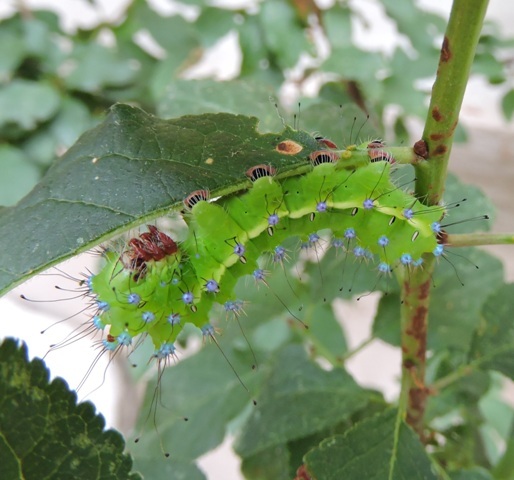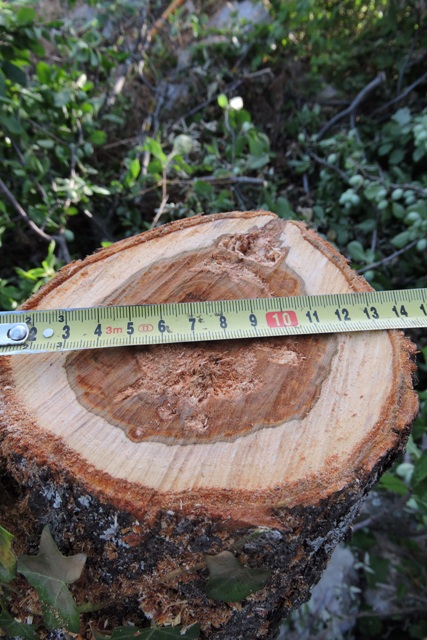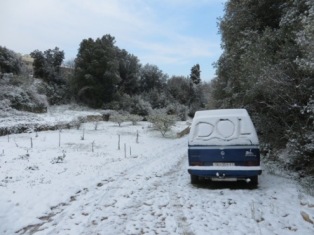Half full or half empty?
This week: Watering concrete; More disease; It’s a funny thing; Leaving the seeds;

That’s it then! It’s July and we’re half way through the year so it’s down hill all the way to winter… Is the glass of 2022 half full or half empty?
But while I always feel somewhat sad as the nights begin to draw in, we still have the heat of summer to come. The end of July and the first two weeks of August are always the hottest in the year, and they are three weeks away.
The heat is not letting up and the rain is staying away. We are 60mm below the average for this week of summer. That is 60 litres per square metre, so there is little wonder that everything is as dry as dust.

It is just too hot to work in the sun, so by 9 am I have usually retreated to do some inside jobs.

Last week I mentioned I had found a large and brightly coloured caterpillar on a plum tree in the courtyard. After an internet search, I had wondered if it was a Japanese Silk Moth.

Late on Saturday night I received a message from Kevin Hinson, a moth expert saying that it is the caterpillar of the Giant Peacock Moth, Saturnia pyri.
I see these moths each spring, but have never seen their caterpillars before. The Giant Peacock moth is the largest European moth.

With the end of the month comes the PMCC magazine and I have spent every spare minute this week and some more besides, putting together the latest issue which was published on Friday.
So as usual, it has been another busy week all round.
Watering concrete
I had a telephone call early on Monday from my friend Cvjetko, to say he would come about 9am, with cement and his mixer to lay some concrete.
It is all part of my master plan for the orchard, where I extend the existing wall and flower bed.

At the end of the top orchard, there is a two metre embankment which is the boundary with the bottom orchard. This is somewhat unstable, being held back by a dry stone wall and little else apart from gravity.
Over the years, trees have taken root in the wall and whilst they provide some stabilisation, they are also undermining the wall.
At the same time, I want to plant more shrubs, to stabilise the soil close to the wall and also to use a space which otherwise would not be used.
I planned to use some dense concrete blocks to hold soil in a raised bed, but need a strong foundation.
Having mixed concrete by hand, it is hard work. Mixing concrete by hand in summer is horse work, so I asked Cvjetko if he had a spare couple of hours, if I could use his concrete mixer.
It was just a matter of when.
So on one of the hottest mornings so far of this summer, I was out early fixing wooden shutters and then cutting and driving steel rebar into the soil, but protruding above, into the concrete, to lock it in place.
The Church bells had just chimed 9 and I had finished everything and was rolling out the hosepipe when Cvjetko arrived with his mixer and work colleague.
I already had the aggregate so with water, concrete and manpower, it was only minutes before the first wheelbarrow load was being poured.
It took less than an hour to mix three loads in the cement mixer and barrow them downhill into the orchard. It is MUCH easier barrowing full loads down, and and an empty barrow up!
We finished before ten, just in time for coffee and cake.
The height of summer is not the time to be mixing concrete. Concrete doesn’t dry, it sets in a chemical reaction. Lime mortar once mixed and used, can be ground down and used again.
Cement once it has been used, cannot be ground down and reused.
If the chemical reaction is too fast, the concrete cracks and loses its strength. So to prevent cracking, I have been watering the new concrete, to keep it cool.

Perhaps if I water it long enough, it might grow…. 😉
More disease
There were a few established trees in the orchards when I bought my Dol house. Some were very large, like the plum trees in the Top Orchard, others were smaller and had been eaten by the goats.
Once the goats had left, these trees could grow, and grow they did.
A small plum tree in the orchard was of a different variety to the others. It flowered early, but had large plums which I thought might have been a type of Victoria plum.
However, each year when the plums ripened, they were inedible. Large and with a purple colour, like a Victoria, the flesh was hard and bitter.
This is my first experience of an inedible variety of plum.
One of the questions I asked when I moved here, was about what had been planted. There were no records and the owner was non resident, having rented out the property to casual renters.
So I have no idea of the varieties of anything which I have not planted myself, including this plum.
I needed to trim a couple of branches back this week to allow me to continuing to build the rockery wall.
The moment I cut into the first branch, I could see what the problem is. The heartwood of the tree is black and diseased.

I presume that this has been the cause of the inedible fruit.
After my experience of recent years, I had decided to remove the tree. If something is not productive in the centre of an orchard, then sometimes the hard decision, after trying all remedies, is to remove it.
Other than the black heart wood, there was no external sign of disease, other than strange behaviour, like blossoming twice, and early leaf drop.
I used the chain saws to gradually reduce the size of the tree, but when I cut the top of the main trunk, I could see how bad the disease was.
A full two thirds of the trunk, starting from the centre was diseased, and in places it was just powder.

I already have two replacement saplings in the nursery, so although I feel bad having to cut the tree down, it will be replaced.
If I remove a tree, I always plant two in its place. I have two columnar varieties, an Aprikyra which is a cross between and Apricot and a Cherry, and a local plum variety, similar to a Victoria called Imperial.

These are in their pots in my nursery area and will be planted out this this winter.
Meanwhile after I cut the plum down, it was then the turn of the digger to remove the remains of the roots and prepare for some more stones to be laid.

It’s a funny thing
In temperate climates (which can no longer be determined by latitude), gardening and seed catalogues start to thump through letter boxes onto door mats, or fill up email in-trays from September.
With beautiful staged photography, the physical books (for me preferable to online browsing) were a winter treat on a cold night, thinking about what would be nice to order for the following year.
At the start of his week a new book arrived for me from Cyprus, called Flowering Plants for Hot Gardens, which seems entirely appropriate when the outside temperature is already over 35ºC, and there is 60% humidity.

On Thursday, the Postman delivered a second book, an ex library book from Abe Books called Australian Plants for Mediterranean Climate Gardens.

When the sun is baking the ground outside, it is rather enjoyable to sit in the naturally ventilated cool indoors, reading and looking to see what ideas there are for some different plants for the garden.
On Wednesday I had a conversation with a neighbour over some of his very nice white wine, about climate breakdown, his problems with lack of water for olives and what we as individuals can do. There were no real answers…
It was only when I dug out the roots of my old diseased olive last week that I started to read up on olive tree roots. I mean they are well hidden underground and get on with doing their own thing, don’t they?
Olives are unusual. For the first three or four years of life, the roots penetrate downwards, like other trees. Then around the fourth or fifth year, the original roots are replaced by new, “flocculent” roots which grow out laterally in a thick mass from just below the neck of the tree trunk.


The soil composition does also influence the rate of root development, but it accounts for why I couldn’t find any tap root when I dug my tree out last week.
My neighbourly discussion centred on how I am looking five or more years ahead, using data from my weather station about the annual changes I am seeing, to think about plants and trees which will thrive in the “new normal” of climate breakdown.
Good books help enormously, not just in the landscape design, but also to see what might be possible in the future.
Whilst the summers are getting warmer and drier, the big unknown is the winters. We can get unusual cold spells here in Dol. The last was in January 2017 where a Bura combined with low temperatures resulted in the death of most citrus trees in and around the village.

So it is a balance of survivability in summer heat and drought, but also being able to survive occasional winter cold. Fortunately there are species which fit this requirement.
Leaving the seeds to mature
Plants are adaptable sorts, to a degree. Just don’t try growing Azaleas or Rhododendrons on alkaline soils!
The native wild flowers have mostly died back now, and where the paths were green a few weeks ago, the lack of rain combined with the hot summer sun has turned almost everything brown.
Just a couple of species enjoy this heat, one being the deep rooted Dwarf Mallow.

In the garden, the wild Gladioli, Gladiolus Illyricus, which looked so lovely a few weeks ago are slowly drying out.

Their seed pods are now well formed and I will be waiting until the seeds are ripe, before I cut them back.

I would like to have a seed exchange, so people on the island who want seeds of some of these native species can have them and plant them.
Another plant which is local to central and southern Europe is Honesty, Lunari annua.

It has been spread to most temperate regions of the world but can still be found growing on disturbed land around my home.
With the low evening sun illuminating the seed pods of my plants, they are about ready to harvest.

I will sprinkle some seeds on the soil in the same small bed under the plum tree, where they enjoy the shady, damp conditions, so I will have more flowers next year.
In the olives there are some of the annual thistles just coming into flower.
Meanwhile the Bougainvillea, originally from South America, but now a staple of summer Mediterranean gardens is at its best. NCG


3 Responses
Marcy
Hi Norman, The flower images and descriptions are amazing. I’m loving the growth of your orchards and flowers. Thank you for sharing. I thought this might be helpful to get your weed problem under control. You may have already researched it. It worked for me. https://www.birdsandblooms.com/gardening/gardening-basics/make-your-own-weed-killer-with-vinegar/#:~:text=vinegar%20does%20kill%20weeds%2C%20especially,weed%2C%20which%20dries%20it%20up.
The national holiday is upon us and the weather is accommodating so far. It’s rained and been cloudy, but I suspect that’s gone for now.
Wishing you a great week, and as always, thank you for sharing.
Marcy
Tony Griggs
Cool up here at the Muckle Flugger lighthouse today Norman!
Michael C-W
Norman,
don’t worry about cutting down a non-productive tree. It was a waste of space and it’s much better to have something useful. And there’s an old saying, a good gardener is a ruthless gardener!